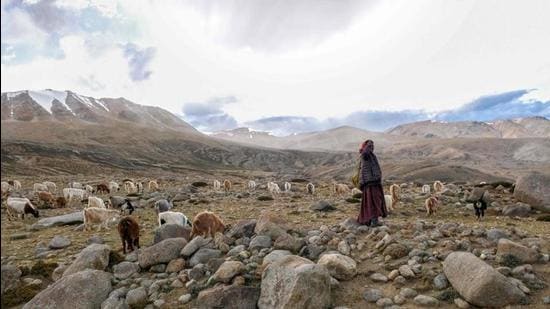China built villages near LAC, boosted military infra to keep up pressure on India
Indian security agencies too have gathered extensive information on the campaign to speed up building of border villages along the LAC, ranging from Xinjiang to Arunachal Pradesh. Work on houses and roads to these villages is being completed at a rapid pace even during the pandemic.
China has combined a policy of building villages close to the Line of Actual Control (LAC) from Xinjiang to Bhutan with simultaneously bolstering military facilities and dual-use infrastructure such as airports to keep up the pressure on India, people familiar with developments have said.

Details of the way in which China systematically pumped in money for almost a decade to build “villages of moderate prosperity” along the 4,000-km border of Tibet, most of which aligns with the LAC, emerged in a new policy paper on Tibet Autonomous Region (TAR) released by the State Council Information Office on Friday.
By the end of 2020, many border villages in the remote region were better connected to highways, and all had access to mobile communication, according to the policy paper titled Tibet Since 1951: Liberation, Development and Prosperity.
Indian security agencies too have gathered extensive information on the campaign to speed up building of border villages along the LAC, ranging from Xinjiang to Arunachal Pradesh. Work on houses and roads to these villages is being completed at a rapid pace even during the pandemic, the people cited above said on condition of anonymity.
“Residents are moved into the villages, mostly located in disputed regions, from other areas. Some are at a short distance from strategic features on the Indian side of the LAC,” one of the people cited above said.
“We have received inputs on such villages coming up on the western sector of the LAC in Xinjiang and Tibet and the eastern sector in Arunachal Pradesh. The worrying aspect is the new pressure on Bhutan in the eastern sector of its border with China, which appears to be aimed at making Bhutan give up territory in the Doklam region,” the person added.
The pressure on Bhutan is being mounted apparently with an eye on the planned 25th round of boundary talks with China, dates for which are yet to be decided, the people said.
Several villages have come up in the tri-junction between India, Bhutan and China, and a new village is said to have come up close to Longju, near Arunachal Pradesh, which witnessed the first clash between India and China in 1959, according to India-based Tibet expert Claude Arpi.
The policy paper said 118,800 km of highways were built to provide access to all administrative villages in TAR. Ninety-four per cent of towns and 76% of administrative villages have direct access to asphalt and concrete roads.
“A number of feeder airports have been built, including Bamda Airport in Qamdo, Mainling Airport in Nyingchi, Peace Airport in Xigaze, and Gunsa Airport in Ngari,” the paper said. Many new airports are located close to border areas, especially with India.
The people cited above said Chinese authorities also have plans to build three more airports in Lhunze, Tingri and Burang counties as part of an expansion project that will involve the construction of a second runway at Lhasa Gonggar airport.
“These are all dual-use infrastructure and can be used by the military in contingencies,” said a second person.
At the same time, the People’s Liberation Army (PLA) air force is retiring its ageing Chengdu J-7 jets at an air brigade in Lintao under the Western Theatre Command, which covers Tibet and Xinjiang, and replacing them with Shenyang J-16 and Chengdu J-20 jets.
“This will bring in more capable aircraft for operations along the LAC, where the older jets can’t perform very well,” the second person said.
There are also reports of China developing a unmanned aerial vehicle (UAV) specifically for use in Tibet. The UAV reportedly completed its first flight at Gar Gunsa in TAR. “The UAV took off from an elevation of 4,700 metres and completed its task of patrolling, control and search in the Kailash mountain region,” the second person said.
The policy paper’s statement on border villages matches recent reports, many based on independent satellite imagery, that show China is building villages along the LAC to bolster its contested territorial claims.
“Under the guidance of the (Communist Party of China) Party Central Committee, financial input has been increasing year by year for border development in Tibet. Particularly since 2012, border villages, townships and counties in Tibet have been granted more preferential state policies on infrastructure construction...,” the paper said.
The paper didn’t give details on the number of new villages or how many received financial and infrastructure help. However, a 2019 report in the official TAR news portal said the government plans to build 624 “well off” villages and farms on Tibet’s borders. The policy clearly tallies with what President Xi Jinping had said in 2013.
On March 9, 2013, when joining a delegation from Tibet in a panel discussion at the National People’s Congress, Xi had said: “To govern the country well we must first govern the frontiers well, and to govern the frontiers well we must first ensure stability in Tibet.” In 2017, Xi also wrote a letter to Tibetan herdsmen living near the Arunachal Pradesh border to “set down roots” and safeguard “Chinese territory”.
TAR has the longest international border with India, besides shorter frontiers with Nepal and Bhutan, and the shortest with Myanmar. China has land boundary disputes with India and Bhutan that haven’t been resolved despite protracted negotiations over decades.
Sameer Patil, fellow for international security studies at Gateway House, said: “China had the first mover advantage by beefing up border infrastructure on its side some years ago. Then the Indian side began strengthening infrastructure on its side. The Chinese side’s thinking appears to be that they were losing the advantage and they’re now undertaking a host of measures retain that advantage.”



